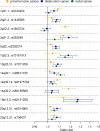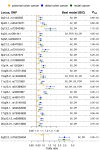Genetic architectures of proximal and distal colorectal cancer are partly distinct
- PMID: 33632709
- PMCID: PMC8223655
- DOI: 10.1136/gutjnl-2020-321534
Genetic architectures of proximal and distal colorectal cancer are partly distinct
Abstract
Objective: An understanding of the etiologic heterogeneity of colorectal cancer (CRC) is critical for improving precision prevention, including individualized screening recommendations and the discovery of novel drug targets and repurposable drug candidates for chemoprevention. Known differences in molecular characteristics and environmental risk factors among tumors arising in different locations of the colorectum suggest partly distinct mechanisms of carcinogenesis. The extent to which the contribution of inherited genetic risk factors for CRC differs by anatomical subsite of the primary tumor has not been examined.
Design: To identify new anatomical subsite-specific risk loci, we performed genome-wide association study (GWAS) meta-analyses including data of 48 214 CRC cases and 64 159 controls of European ancestry. We characterised effect heterogeneity at CRC risk loci using multinomial modelling.
Results: We identified 13 loci that reached genome-wide significance (p<5×10-8) and that were not reported by previous GWASs for overall CRC risk. Multiple lines of evidence support candidate genes at several of these loci. We detected substantial heterogeneity between anatomical subsites. Just over half (61) of 109 known and new risk variants showed no evidence for heterogeneity. In contrast, 22 variants showed association with distal CRC (including rectal cancer), but no evidence for association or an attenuated association with proximal CRC. For two loci, there was strong evidence for effects confined to proximal colon cancer.
Conclusion: Genetic architectures of proximal and distal CRC are partly distinct. Studies of risk factors and mechanisms of carcinogenesis, and precision prevention strategies should take into consideration the anatomical subsite of the tumour.
Keywords: cancer genetics; cancer susceptibility; colon carcinogenesis; colorectal cancer; genetic polymorphisms.
© Author(s) (or their employer(s)) 2021. Re-use permitted under CC BY-NC. No commercial re-use. See rights and permissions. Published by BMJ.
Conflict of interest statement
Competing interests: None declared.
Figures


References
-
- American Cancer Society . Cancer statistics center. Available: http://cancerstatisticscenter.cancer.org [Accessed 21 Apr 2020].
Publication types
MeSH terms
Grants and funding
- P01 CA087969/CA/NCI NIH HHS/United States
- P30 CA015704/CA/NCI NIH HHS/United States
- U01 CA137088/CA/NCI NIH HHS/United States
- U01 CA164930/CA/NCI NIH HHS/United States
- HHSN268201200008C/HL/NHLBI NIH HHS/United States
- UM1 CA186107/CA/NCI NIH HHS/United States
- R01 CA207371/CA/NCI NIH HHS/United States
- 25004/CRUK_/Cancer Research UK/United Kingdom
- 16561/CRUK_/Cancer Research UK/United Kingdom
- R01 CA059045/CA/NCI NIH HHS/United States
- R35 CA197735/CA/NCI NIH HHS/United States
- U10 CA037429/CA/NCI NIH HHS/United States
- U01 CA182883/CA/NCI NIH HHS/United States
- R00 CA158141/CA/NCI NIH HHS/United States
- UG1 CA189974/CA/NCI NIH HHS/United States
- R01 CA151993/CA/NCI NIH HHS/United States
- R21 CA191312/CA/NCI NIH HHS/United States
- U01 CA206110/CA/NCI NIH HHS/United States
- P30 CA008748/CA/NCI NIH HHS/United States
- 19167/CRUK_/Cancer Research UK/United Kingdom
- U01 CA167551/CA/NCI NIH HHS/United States
- R01 CA143237/CA/NCI NIH HHS/United States
- R01 CA201407/CA/NCI NIH HHS/United States
- R01 CA042182/CA/NCI NIH HHS/United States
- K99 CA158141/CA/NCI NIH HHS/United States
- UM1 CA182883/CA/NCI NIH HHS/United States
- K07 CA190673/CA/NCI NIH HHS/United States
- HHSN268201200008I/HL/NHLBI NIH HHS/United States
- P30 CA071789/CA/NCI NIH HHS/United States
- 001/WHO_/World Health Organization/International
LinkOut - more resources
Full Text Sources
Other Literature Sources
Medical
